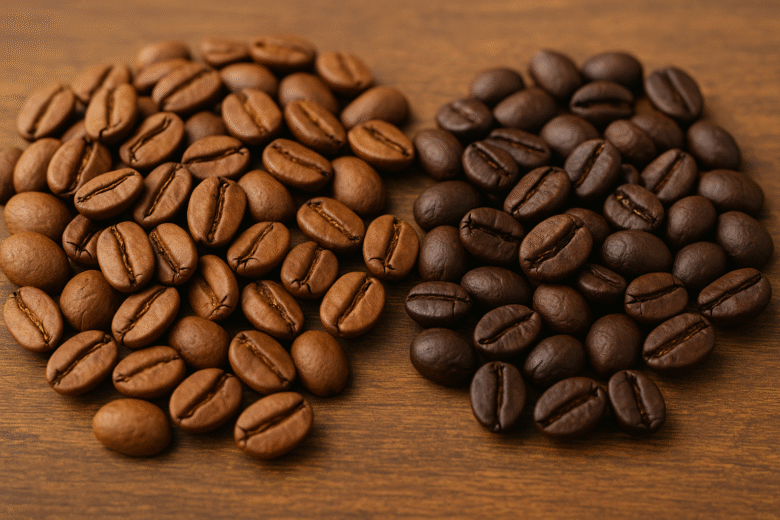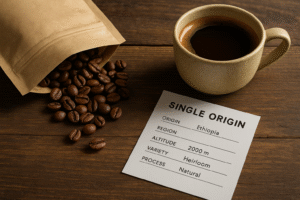When it comes to coffee beans, two main species dominate the global market: Arabica and Robusta.
While there are other lesser-known varieties, these two account for over 95% of the world’s coffee consumption. They differ not only in where they grow and how they’re cultivated, but also—most importantly—in how they taste.
Understanding the differences in flavor between Arabica and Robusta is essential for anyone who wants to deepen their appreciation of coffee.
Whether you’re choosing beans at the grocery store, selecting a roast at your favorite café, or brewing at home, knowing what each species brings to the cup will help you make better, more informed choices.
In this article, we’ll explore the origins, growing conditions, taste characteristics, and brewing considerations of both Arabica and Robusta.
By the end, you’ll have a clear understanding of what sets them apart and how to choose the right one for your taste.
What Is Arabica Coffee?
Coffea Arabica is the most popular coffee species worldwide, accounting for about 60–70% of global production. It is considered the superior bean in terms of flavor, complexity, and aroma.
Arabica plants are more delicate and grow best at higher altitudes, typically between 1,000 and 2,000 meters above sea level. They require cooler temperatures, more shade, and more care compared to Robusta.
Arabica beans are oval in shape with a curved crease down the middle. They contain less caffeine than Robusta—typically about 1.2–1.5%.
What Is Robusta Coffee?
Coffea Canephora, commonly known as Robusta, makes up about 30–40% of the world’s coffee production. It is often used in espresso blends and instant coffee due to its strong, bold characteristics.
Robusta plants are hardier and easier to grow. They thrive at lower altitudes and are more resistant to pests and disease. They can withstand higher temperatures and require less shade and moisture.
Robusta beans are rounder and smaller than Arabica beans. They have a straighter crease and contain significantly more caffeine—around 2.2–2.7%.
Flavor Profile of Arabica
Arabica is prized for its smoothness, sweetness, and complexity. It typically has a lighter body and more acidity compared to Robusta.
Common flavor notes in Arabica include:
- Fruit (berries, citrus, stone fruits)
- Floral tones (jasmine, rose)
- Chocolate and caramel
- Nutty and sweet undertones
- Bright and clean finish
The specific taste can vary dramatically depending on origin, altitude, roast level, and processing method. For example, Ethiopian Arabica may have bright citrus and floral notes, while Brazilian Arabica may lean toward chocolate and nuts.
Arabica’s complexity makes it ideal for black coffee, pour-over, and specialty brews.
Flavor Profile of Robusta
Robusta has a stronger, more bitter flavor with a heavier body. It tends to be more earthy, woody, or even nutty, with less complexity than Arabica.
Typical flavor notes include:
- Dark chocolate
- Earth or tobacco
- Grain or cereal
- Burnt or smoky undertones
- Very low acidity
Because of its bitterness and depth, Robusta is often used in espresso blends to provide a richer crema and more caffeine kick.
In its pure form, Robusta can be intense, but high-quality Robusta grown in ideal conditions can also be quite pleasant and distinctive.
Caffeine Content and Its Impact on Flavor
One of the key differences between Arabica and Robusta is caffeine content. Robusta has nearly double the caffeine of Arabica, which contributes to its bitterness.
Caffeine is a natural insect repellent, so Robusta’s high caffeine level helps it resist pests. However, this also gives it a more astringent and harsher taste.
In contrast, Arabica’s lower caffeine allows for sweeter and more nuanced flavor development.
If you prefer a smoother cup with less bitterness, Arabica is the better choice. If you want something with a kick and bold intensity, Robusta delivers.
Acidity: Brightness vs Boldness
Acidity in coffee refers to brightness or liveliness on the palate, not the pH level. Arabica is known for its vibrant acidity, which gives the cup complexity and dimension.
Robusta has low acidity, making the coffee feel flatter but also less sharp. This works well for milk-based drinks or for those who find acidic coffees too sour or sharp.
If you enjoy light, citrusy, or fruity coffees, Arabica offers a wide range. If you prefer earthy, dark, and rich flavors, Robusta may suit your taste.
Aroma Differences
Aroma is a major part of how we experience flavor. Arabica’s aroma is often described as:
- Sweet and floral
- Bright and fruity
- Nutty and chocolaty
Robusta’s aroma is more:
- Earthy and woody
- Rubber-like or burnt (in lower-quality beans)
- Nutty or grainy
These differences are immediately noticeable when you open a bag of beans or grind them fresh.
Crema in Espresso
In espresso preparation, Robusta contributes a thicker crema, the golden-brown foam on top of a shot.
Many baristas use a blend of Arabica and Robusta for the perfect espresso balance—Arabica for flavor and aroma, Robusta for body and crema.
A typical espresso blend might use 80% Arabica and 20% Robusta, combining the best of both worlds.
Price and Availability
Arabica beans are generally more expensive due to their growing conditions and processing requirements.
Robusta is more affordable and often used in commercial blends, instant coffee, and supermarket brands.
That said, premium Robusta is gaining popularity, especially among specialty roasters in countries like India, Uganda, and Vietnam.
Both beans have their place, and price does not always equal quality—processing and roasting play a huge role.
Health and Caffeine Effects
Robusta’s higher caffeine content may be desirable for people who want a strong energy boost. It also contains more antioxidants.
However, some people are sensitive to caffeine and may find Arabica more comfortable to drink regularly.
Both beans offer potential health benefits, but your personal caffeine tolerance should guide your choice.
Which One Is Right for You?
Choose Arabica if you prefer:
- Fruity, floral, or sweet flavors
- Bright acidity and a clean finish
- Drinking coffee black or as pour-over
- Lower caffeine levels
- More variety in origin and taste
Choose Robusta if you prefer:
- Bold, earthy, or bitter flavors
- Heavy body and strong kick
- Adding milk or cream to your coffee
- Lower cost per pound
- More crema in espresso
You can also explore blends that combine both for a balanced experience.
How to Tell Them Apart
You can usually spot the difference by looking at the beans:
- Arabica: oval shape, curved crease
- Robusta: rounder shape, straight crease
In terms of taste, Arabica is smoother and more aromatic. Robusta is bolder, darker, and more intense.
Many coffee packages will list the type of bean used. If it’s not specified, it’s often a blend or Robusta-dominant.
Exploring Both in Your Coffee Journey
You don’t have to pick a side. Try both and learn how they fit different moods or recipes.
Experiment with:
- 100% Arabica single-origin pour-over
- Espresso blend with a touch of Robusta
- Vietnamese iced coffee made with Robusta
- French press using medium-dark Arabica
Your palate may change over time, and both beans have something unique to offer.
Conclusion: Two Beans, Endless Possibilities
Arabica and Robusta are not rivals—they’re complementary. Each has its own identity, strengths, and flavor contributions.
By learning to recognize their differences, you gain the power to choose coffees that match your taste, your brewing method, and your energy needs.
Whether you crave a delicate floral note or a deep, smoky finish, the world of coffee is richer for having both.

Marcio Luzardo is a coffee enthusiast and the voice behind Tudo Viraliza. With a passion for turning curiosity into practical knowledge, he shares easy-to-follow tips, guides, and insights to help readers enjoy better coffee every day. When he’s not writing, Marcio is exploring new brewing methods or diving into the rich stories that connect coffee to culture, lifestyle, and wellness.



